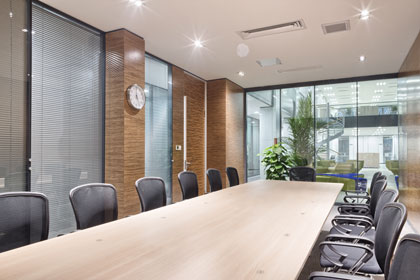In the modern workplace, the lines between physical office, remote location and digital workspace continue to blur. For companies that are redesigning their work-environment strategy, especially those building hybrid offices, the integration of learning & development (L&D) software is now a strategic imperative.
The Changing Face of the Office
The modern office is no longer just a static place where everyone comes, sits, and leaves. It’s increasingly an ecosystem of in-office zones, remote setups and digital meeting spaces, all interconnected. In this hybrid model, work happens both on-site and off-site—and equally, learning must follow. The old model of “book a classroom, show up, listen, go home” doesn’t fit the tempo of hybrid teams.
By designing offices that support flexible work (with touchdown areas, team hubs, focus pods and video-enabled rooms), organizations set the stage for embedding learning into the rhythm of the day. Instead of separate “training days”, the office becomes both a workspace and a learning space. In doing so, you create a seamless link between how people work and how they grow.
Designing Learning-Friendly Hybrid Spaces
A hybrid office optimized for both productivity and learning has a few key features:
- Dedicated “learning zones”: These are areas within the workspace specifically set aside for training modules, micro-sessions, peer learning or quiet individual study. They may sit adjacent to normal collaboration spaces but be acoustically or visually separated so that learning can proceed undisturbed.
- Technology-enabled meeting/training rooms: Hybrid learning inevitably involves some participants in the room, others remote. These rooms should include high-quality displays, cameras, sound systems, virtual whiteboards or interactive surfaces so that remote learners are fully included.
- Flexible furniture and layout: Learning pods, modular seating, mobile screens—all allow a space to shift from meeting mode to workshop mode to quiet individual learning.
- Integration with typical work areas: Because learning happens “in the flow of work”, it’s ideal when your workspace allows an employee to transition from doing their job to engaging in a learning module without friction. The emphasis on wireless power and seamless infrastructure sets a precedent: just as a workspace should eliminate cable clutter and friction, so too should a learning environment eliminate friction in access, scheduling and engagement.
In essence: the office isn’t just where you do work, it’s also where you grow. Employees should feel they can learn, collaborate and innovate in the same place.
Role of L&D Software in the Hybrid Learning Strategy
Modern learning doesn’t wait for a training day — it supports just-in-time access, peer interaction and managerial oversight. The right L&D software enables this flexibility. One particularly robust example is D2L, whose corporate learning solution is designed for business scale and distributed work environments.
Key capabilities to look for include:
- Adaptive learning paths: The software tailors content to each employee’s skill level or career goals, so whether someone is working in-office two days a week, or fully remote, their learning journey remains relevant and timely. D2L emphasizes that modern businesses need learning platforms that scale, build in-demand skills, retain talent and make work more efficient.
- Micro-learning modules: Short, focused courses (e.g., 5-10 minutes) that can be completed between meetings, during transit to the office, or just prior to a hybrid workshop. These are ideal for hybrid schedules. D2L’s design supports mobile access and micro-learning for busy professionals.
- Social and peer learning: Discussion forums, chat within the L&D platform, peer-to-peer sharing replicates the informal “water-cooler” learning experiences less frequent in hybrid settings. D2L mentions social learning and leaderboards as part of engaging employees and driving retention.
- Analytics & dashboards: For managers and L&D teams, hybrid environments make oversight trickier. Robust dashboards show participation, progress, and skill development across both in-office and remote populations. D2L emphasizes analytics, tracking, ROI-focused learning outcomes.
- Integration into workflow tools: The best L&D software plugs into existing productivity platforms (Teams, Slack, etc.) so learning prompts, modules and notifications show up where people already work—not in a separate silo.
When these features are paired with a workspace that already supports flexibility and tech-enabled connectivity, the result is a holistic hybrid learning ecosystem. Employees don’t “stop work to learn” — they learn as they work, in the moment.
Cultivating a Continuous Learning Culture
Technology and design alone won’t guarantee success. Culture remains critical. In hybrid offices, leaders need to champion learning and make it visible and valued. Some tactics:
- Managers should schedule regular “learning check-ins” (not just project check-ins) to reinforce that skill development is part of the work rhythm.
- Design the office with visible display boards (digital screens or physical signage) showing team learning progress—so when people come together in person, learning is part of the conversation.
- Recognize and reward learning milestones via the L&D software (badges, certificates, peer shout-outs) and in your in-office environment (e.g., a “learning wall” near the coffee zone). D2L supports credentialing and certifications as part of its business LMS offering.
- Encourage peer-led micro-sessions: someone in the office hosts a quick 15-minute “tech-tip drop-in” for remote colleagues via hybrid-room setups.
By embedding learning into the daily flow of the hybrid workspace, organizations send the message: growth isn’t optional—it’s essential.
The Benefits of Integration: Agility, Engagement, Retention
When you bring together a flexible workspace and a smart L&D software platform like D2L, several benefits follow:
- Organizational agility: The hybrid model demands that employees adapt quickly to new roles, tools and ways of working. A learning platform embedded in the workspace enables faster skill development. D2L specifically calls out that transformative learning helps organizations stay ahead of talent disruption.
- Employee engagement: When learning is visible, integrated into the office environment—both physical and digital—employees perceive it as part of their day rather than an add-on. That increases buy-in and participation.
- Talent retention: Especially in hybrid or remote contexts, employees who feel connected and invested in are more likely to stay. A workspace that supports both their day-to-day and their growth journey strengthens loyalty. D2L mentions that 92% of L&D leadership feel effective training programs contribute to higher retention.
Looking Ahead — Smart Learning Ecosystems in Hybrid Workspaces
The future of workspaces is smart, connected and learning-friendly. Offices will continue to evolve into flexible hubs where people gather as needed, work remotely when needed, and learn whenever needed. Likewise, L&D platforms like D2L will continue to evolve with AI-personalisation, immersive VR/AR modules, and deeper integration into the physical workspace.
For organizations designing or redesigning their workspaces, the message is clear: consider learning as part of your workspace strategy. At ChargeSpot, where powering the workspace is front and center, it’s fitting to extend that power to personal and professional growth. Equip your space with the right infrastructure, choose an L&D software like D2L that fits a hybrid model, and you’ll create a workspace that doesn’t just enable work—but enables learning and future readiness too.



